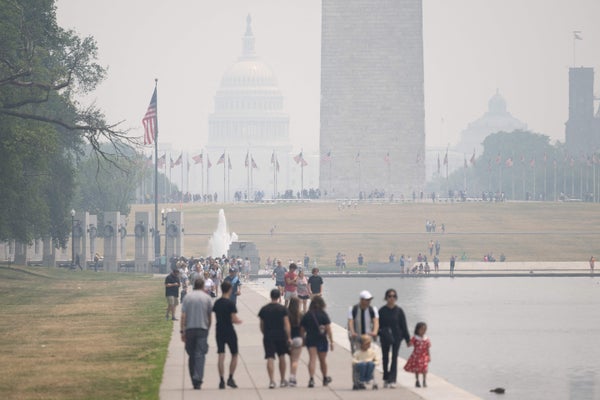October 31, 2024
4 min read
Vote for a Healthy Climate for Our Children
The 2024 presidential election will have enormous consequences for the climate, and the health and future of children

Tourists walked on the National Mall as smoke from wildfires in Canada caused an acrid smell and hazy conditions in Washington, DC, on June 7, 2023. Washington authorities warned that the air quality was “unhealthy for people with heart or lung disease, older adults, children and teens” and canceled all outdoor activities in public schools, including sports lessons.
Saul Loeb/AFP via Getty Images
For America’s children, the coming election will be one of the most consequential in our nation’s history. Climate change is taking a huge toll on children’s health, and the election will determine whether we continue to curb fossil fuel pollution and slow global warming, or whether we reverse the hard-won achievements of recent years with catastrophic consequences.
The Republican candidate, former president Donald Trump, has dismissed global warming as a “scam” and has vowed if elected to vigorously expand drilling for oil and gas. He has pledged to roll back or repeal the clean energy and climate policies of the Biden administration, notably targeting the 2022 Inflation Reduction Act (IRA) that has provided about $370 billion to reduce greenhouse gas emissions and transition to clean renewable energy. The deregulatory road map for a second Trump administration called “Project 2025” similarly features unlimited fossil fuel production, and a repeal of the IRA and other climate and environmental regulations.
In contrast, the Democratic candidate, Vice President Kamala Harris, describes climate change as an “existential” threat. As vice president she cast the tie-breaking vote allowing passage of the IRA and supported new emissions standards that will curb pollution from oil and gas operations, cars, trucks and dirty power plants. Harris announced more than $1 billion in grants in 2022 for states to address flooding and extreme heat exacerbated by climate change, and she has championed environmental justice programs to reduce the impact of climate change and fossil fuel pollution on marginalized communities.
On supporting science journalism
If you’re enjoying this article, consider supporting our award-winning journalism by subscribing. By purchasing a subscription you are helping to ensure the future of impactful stories about the discoveries and ideas shaping our world today.
Researchers like myself who study the health effects of climate change and air pollution in children, from in utero through adolescence, have found that climate change is a threat multiplier, placing nearly every child in the U.S. and around the world at risk from at least one climate-intensified hazard: extreme heat, severe storms and floods, wildfires, food insecurity and insect-borne diseases.
The toll on the physical and mental health of children is huge—and growing. More babies are being born preterm or at low birth weight consequent to a mother’s prolonged exposure to severe heat or forest fire smoke during pregnancy. Babies, young children and adolescent athletes may experience hyperthermia, kidney disease and even death from exposure to severe heat. Every year wildfires in the U.S. West expose over seven million children to lung-damaging smoke, often triggering asthma attacks. Infectious diseases like Lyme have been on the rise among children, largely because of climate change. Children are also experiencing physical and psychological trauma from severe storms and floods, and many suffer from PTSD and depression as a result. Awareness of the health effects of climate change heightens kids’ risks of anxiety and other mental health problems, to the point where almost half of young people recently surveyed said that their worries about climate change were negatively affecting their daily lives. Extreme heat exposure can cause children to have poor cognitive function and reduced ability to concentrate, learn and perform academically, potentially affecting future income.
Air pollution is now recognized as a parallel health crisis for which fossil fuel emissions are largely responsible. Long recognized as a trigger of asthma attacks in children, air pollution is now understood to be a direct cause of asthma and other respiratory diseases. Everything from infant death and childhood asthma to mental health conditions has been linked to air pollution. Like climate change, air pollution exposure is affecting children’s ability to learn. In a New York City study, my colleagues and I found that IQ scores and academic achievement dropped in children prenatally exposed to air pollution from cars, construction and industry.
While all children are vulnerable, low-income, Black and Hispanic children face disproportionate exposure to air pollution in disadvantaged neighborhoods. Discriminatory policies, such as redlining, have created urban heat islands in communities of color where there are fewer trees and shaded areas.
On the healthy side of the ledger, the climate and energy provisions of the Inflation Reduction Act will reduce emissions of greenhouse gases by one billion metric tons in 2030, putting us in reach of our nation’s target of at least 50 percent emissions reduction. By then, the IRA would also sharply reduce levels of small inhalable particles, preventing up to 4,500 premature deaths, 119,000 asthma attacks, and about 179,000 cases of respiratory symptoms and bronchitis, plus thousands of hospital admissions and respiratory ER visits every year. The avoided deaths would be concentrated in communities of color, which have historically experienced the greatest harm from air pollution. The estimated economic benefits are as high as $49 billion for 2030 alone. The global climate benefits of the IRA for that same year amount to $137 billion.
This isn’t the first time policies have been shown to greatly benefit health and the economy. The U.S. Clean Air Act and Amendments achieved an average 78 percent reduction in national emissions of common air pollutants between 1970 and 2020. In 2020 alone, Clean Air Act programs had a net economic benefit to public health—lives saved, hospital visits avoided and school days kept—up to $3.8 trillion, plus more than $21 billion in avoided climate-related economic damages.
The Regional Greenhouse Gas Initiative in the U.S. Northeast required power plants to cut carbon dioxide emissions, which led to pollution reductions that averted up to an estimated 830 premature deaths, along with a total of 12,000 heart attacks, respiratory illnesses, preterm and low weight births, and cases of asthma and autism spectrum disorder.
Government policies can protect our health and the economy, with our children being the greatest beneficiaries. This election will impact the health of our children now and in the future.
This is an opinion and analysis article, and the views expressed by the author or authors are not necessarily those of Scientific American.

